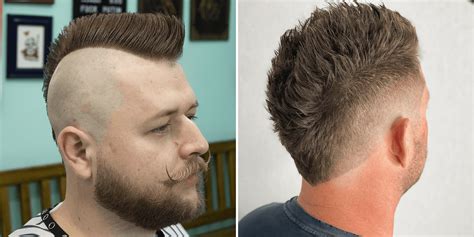What’s the difference between a faux hawk and a mohawk?

It’s a question that’s been asked by style-conscious individuals for years. While both hairstyles share some similarities, there are also some key differences that set them apart.
In this article, we’ll take a closer look at faux hawks and mohawks, and explore the 12 key differences that you need to know.
The most obvious difference between a faux hawk and a mohawk is the length of the hair. A faux hawk typically has short hair on the sides and back of the head, with longer hair on top. A mohawk, on the other hand, has longer hair on the top of the head, with shorter hair on the sides and back.
The shape of a faux hawk and a mohawk is also different. A faux hawk is typically wider at the top than it is at the bottom, while a mohawk is more narrow. This gives the faux hawk a more triangular shape, while the mohawk has a more rectangular shape.
Faux hawks and mohawks are both styled differently. A faux hawk is typically styled using a gel or pomade to create a spiky, textured look. A mohawk, on the other hand, is typically styled using a wax or pomade to create a slick, shiny look.
Faux hawks and mohawks require different levels of maintenance. A faux hawk is relatively easy to maintain, as it can be styled with a variety of products and doesn’t require frequent trims. A mohawk, on the other hand, requires more maintenance, as it needs to be trimmed regularly to keep the shape.
Faux hawks and mohawks are both versatile hairstyles that can be adapted to suit a variety of face shapes and hair types. However, faux hawks are generally considered to be more versatile than mohawks, as they can be styled in a variety of ways.
Faux hawks and mohawks have both been popular hairstyles for many years. However, faux hawks are currently more popular than mohawks, as they are seen as being more modern and stylish.
The cost of a faux hawk or a mohawk will vary depending on the salon you go to and the products you use. However, faux hawks are generally less expensive than mohawks, as they require less time and effort to style.
Faux hawks:
- Pros:
- Versatile and can be adapted to suit a variety of face shapes and hair types
- Relatively easy to maintain
- Less expensive than mohawks
- Cons:
- Can be difficult to style
- May not be appropriate for all face shapes
Mohawks:
- Pros:
- Stylish and edgy
- Can make a statement
- Relatively easy to maintain
- Cons:
- Not as versatile as faux hawks
- Can be difficult to style
- May not be appropriate for all face shapes
The best hairstyle for you will depend on your individual preferences and needs. If you’re looking for a versatile and easy-to-maintain hairstyle, a faux hawk may be a good option for you. If you’re looking for a stylish and edgy hairstyle, a mohawk may be a better choice.
Q: What’s the difference between a faux hawk and a mohawk?
A: The most obvious difference between a faux hawk and a mohawk is the length of the hair. A faux hawk typically has short hair on the sides and back of the head, with longer hair on top. A mohawk, on the other hand, has longer hair on the top of the head, with shorter hair on the sides and back.
Q: Which hairstyle is more popular?
A: Faux hawks are currently more popular than mohawks, as they are seen as being more modern and stylish.
Q: Which hairstyle is easier to maintain?
A: Faux hawks are generally easier to maintain than mohawks, as they require less time and effort to style.
Q: Which hairstyle is more versatile?
A: Faux hawks are generally considered to be more versatile than mohawks, as they can be styled in a variety of ways.
Faux hawks and mohawks are both stylish and edgy hairstyles that can make a statement. However, there are some key differences between the two hairstyles that you should be aware of before making a decision.
If you’re looking for a versatile and easy-to-maintain hairstyle, a faux hawk may be a good option for you. If you’re looking for a stylish and edgy hairstyle, a mohawk may be a better choice.
- Introduction
- 1. Length
- 2. Shape
- 3. Styling
- 4. Maintenance
- 5. Versatility
- 6. Popularity
- 7. Cost
- 8. Pros and cons
- 9. Which hairstyle is right for you?
- 10. FAQs
- 11. Conclusion
- 12. Table of contents
